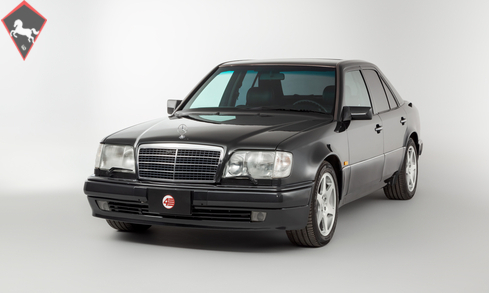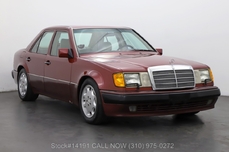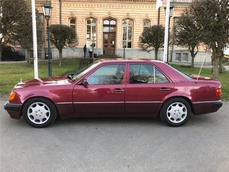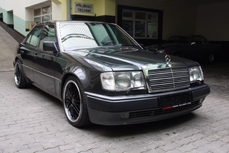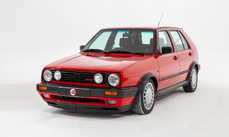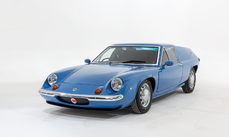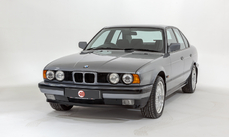Mercedes-Benz 500 w124 E500 1994
General description :
Model History
From 1990 to 1994 Mercedes-Benz sold a high-performance version of the W124, the 500E, which was created in close cooperation with Porsche. In fact, each 500E was hand-built by Porsche, being transported back and forth between the Mercedes plant and Porsche's plant in Zuffenhausen, Germany, during assembly – taking a full 18 days to complete each model. In 1994 it was face-lifted along with the rest of the range and renamed to 'E500'. The 500E and E500 were known by Porsche as Type 2758 in that company's official nomenclature.
The 500E had a naturally aspirated 5-litre V8 engine derived from the R129 500 SL. Sports car braking performance also came from SL components: 300mm front SL 500 discs with 4-piston calipers came installed on the 1992 and early 1993 cars. The later 1993 and all 1994 cars came with the upgraded 320mm set taken from the 600 SL. Rear brakes on all years were 278mm brakes from the 500 SL. Called the "Wolf in Sheep's Clothing" by the press, performance tests of the day yielded impressive results: 0-60mph in just 6.0 with a top speed of around 160mph.
The 500E was built with only four seats and in left hand drive, with the seats supplied by Recaro. With its aggressive stance: 1.5 inches wider track, 0.9 inch lower profile, flared fenders, side skirts, front air-dam and wide tires, the 500E was easily distinguished from its lesser brethren. The 1994 E500 model is more easily identified because of the cosmetic changes that affected all E-Class cars that year, such as updated headlights, grille, and trunk-lid. The engine, however, remained unchanged from the 1993 500E. 1994 models carried an upgraded sound system made by Becker or Alpine, replacing the two-piece Becker 1432 unit used in model year 1992 and 1993 cars. Because of its look, limited numbers, hand-built construction, and unique pedigree, the E500 is already considered a classic, even within Mercedes-Benz.
Equipment
Blue-Black Metallic paintwork, Anthracite leather upholstery, 4-speed switchable automatic transmission, 17-inch Evo II (E500 Limited) alloy wheels, Heated and electric Recaro front seats with memory, Electric tilt/slide sunroof, Electrically adjustable steering column, Automatic air conditioning, Electric windows, Electric door mirrors, Front central armrest, Mercedes cassette radio, Heat-insulating glass, Wood veneer interior trim, Tinted rear windows, Headlamp washer system, Infrared remote central locking, Mercedes tool roll, Spare keys.
Exterior
Hand assembled at Porsche in limited numbers and endowed with a powerful 5-litre V8, the E500 is one of the ultimate 90s Q-cars. Beautifully finished in timeless Blue-Black Metallic, this particular example – one of only 1,855 facelift cars – presents in excellent condition throughout. The paintwork has just been treated to a full machine polish by our in-house detailer and thus maintains a deep, uniform shine with no unsightly swirl marks or signs of previous poor repair. Aside from a handful of light frontal stone chips and one small mark on the edge of the offside rear door there are very few blemishes to report and, having resided on Japan’s unsalted roads since new, there is no rust to be found in any of the common weak spots. All the lights are clear and damage-free, and the anodised trims present with an excellent shine.
VIEWINGS WELCOME BY APPOINTMENT ONLY /// ADDITIONAL PHOTOS AND VIDEOS AVAILABLE UPON REQUEST
Interior
A treat for surely any Mercedes-Benz enthusiast, the E500’s well-equipped interior does not disappoint. Boasting heated and electric Recaro front seats, climatic air conditioning, fine wood trim, and that quality fit and finish 90s Mercedes are so well known for, it’s a superb place to be. The seats are without any major wear and the leather still feels soft to the touch. Having clearly been garaged when not in use the wood veneer is almost entirely crack-free and the headlining is without any sagging issues. In the footwells you’ll find the original Mercedes-Benz overmats, and pleasingly the original cassette radio also remains fitted having never been replaced with an aftermarket head unit.
ENGINE & TRANSMISSION
At the heart of the E500 is of course the Mercedes-Benz 5-litre V8. The engine bay here is very well presented, not overly dressed but in excellent original condition with no signs of any rust or previous poor repair. Having just returned from a full inspection by our trusted classic car specialists the mechanics of the car are in tip-top condition. Reading through the history file it’s clear that this one has always been maintained regularly and to a high standard. Unlike many cars imported from Japan it’s accompanied by a comprehensive and up-to-date maintenance record from new. The last service was carried out by a Mercedes specialist in 2021 at 94,325 miles (151,802km). A fresh MOT will be done upon sale.
WHEELS, TYRES & BRAKES
Filling the arches of this example are desirable 17-inch Evo II alloy wheels, all in perfect unmarked condition having just been fully refurbished with the correct diamond-cut finish by Lepsons. They are shod in a matching set of Michelin tyres all date-stamped 2019, each one with ample tread remaining. The brakes have also been inspected and remain in fine operational condition, effortlessly bringing the car to a stop quickly and in a straight line. New pads were fitted all round in 2020 less than 600 miles ago. Four-wheel alignment has also been carried out recently and so, as you’d expect, it feels as tight as a drum to drive.
History File
Supplied new by Yanase Mercedes-Benz in Japan, this exquisite E500 was first registered in September 1994. It was brought into the UK in 2016 and has seen just one private owner since then, the first registered keeper on the V5C being the company who imported it. The car’s low mileage of 94,739 miles (152,467km) is fully verified by a comprehensive service record from new, and since landing over here its maintenance has continued on regardless of cost. In fact, since 2016 the current owner has spent in excess of £22k on the mechanicals alone!
Within the History File the lucky new owner will be presented with the original Mercedes document pack, all owner’s manuals including original service booklets, a thick raft of UK invoices, two spare keys, and the V5C showing only one former keeper. Services have been recorded at the following mileages: 1,262 – 8,636 – 71,673 – 25,905 – 42,159 – 56,783 – 58,816 – 60,950 – 63,815 – 71,110 – 79,747 – 82,166 – 84,082 – 94,176 – and most recently in February 2021 at 94,325 miles.
http://www.4starclassics.com/for-sale/mercedes-w124-e500-for-sale/
1994 Mercedes-Benz 500 w124 E500 is listed sold on ClassicDigest in Kingsley by 4 Star Classics for £39995.
Car Facts
Car type : Car Make : Mercedes-Benz Model : 500 w124 Model Version : E500 Engine size : 5.0 Model Year : 1994 Sub type : Convertible Location : Hampshire
Sold
Seller Information
Sold
People who viewed this Mercedes-Benz 500 w124 also viewed similar Mercedes-Benz listed at ClassicDigest
Other cars listed for sale by this dealer
About Mercedes-Benz
In the annals of automotive history, the journey of Mercedes-Benz is a tale that unfolds with the ingenuity of its founding pioneers. In the year 1886, Karl Benz crafted the Benz Patent Motorwagen, a creation that would go down in history as the world's inaugural automobile. Unbeknownst to him, this moment marked the genesis of what would evolve into the most illustrious premium car manufacturer globally. The financial underpinning of this pioneering venture, interestingly, was provided by Karl Benz's wife, Bertha Benz, demonstrating a remarkable partnership that would set the tone for Mercedes-Benz's legacy.A parallel narrative emerged not far away, as Daimler-Motoren-Gesellschaft, founded by Gottlieb Daimler and Wilhelm Maybach, entered the scene. In 1901, they unveiled their automobile under the now-famous moniker "Mercedes," meaning "godsend" in Spanish. This name was bestowed upon the car at the behest of Emil Jellinek's daughter, the distributor for Daimler-Motoren-Gesellschaft. The wheels of innovation were set in motion.
Fast forward to 1926, a pivotal year that witnessed the merger of Daimler with Benz & Cie., culminating in the birth of Daimler-Benz. The amalgamation saw the adoption of "Mercedes-Benz" as the distinguished trademark for their automobiles, fusing the legacies of two visionary entities into one.
Contrary to perceptions of conservatism, the trajectory of Daimler-Benz unfolds as a chronicle of industry firsts. From the introduction of the honeycomb radiator to the float carburetor, and the pioneering implementation of four-wheel brakes in 1924, Daimler-Benz consistently pushed the boundaries of automotive innovation. The diesel-powered Mercedes-Benz 260 D in 1936 marked the inception of diesel engines in passenger cars. The iconic Mercedes-Benz 300SL Gullwing made history as the first car with direct fuel injection, albeit the Gutbrod's tiny 2-stroke engine can claim precedence.
Safety innovations became a hallmark, with Béla Barényi's patented safety cell design in the "Ponton"-models in 1951, featuring front and rear crumple zones. The W116 450SEL 6.9 saw the introduction of the Anti-Lock Brake system (ABS), another pioneering safety feature. From the first production airbags and beyond, the legacy of "firsts" continued to be etched into the fabric of Daimler-Benz.
Over its centennial journey, Mercedes-Benz has not merely produced cars but has sculpted automotive icons. The SSKL, 710 SSK Trossi Roadster, 770K Grosser, 540K Spezial Roadster, 300SL Gullwing, w100 600 Pullman, w111 280SE 3.5 Flachkühler, w113 230SL Pagoda, w109 300 SEL 6.3, and w201 2.3-16 Cosworth stand testament to the brand's commitment to engineering excellence.
The roaring Silver Arrows, or "Silberpfeile," including the W 25, W 125, W154, W165, and W196, created a legacy of dominance on the racetrack. These machines were not merely cars; they were expressions of precision, speed, and an indomitable spirit that left their competitors in the dust.
As Mercedes-Benz marches into the future, it does so not just as an automaker but as a custodian of a legacy, a torchbearer of innovation, and a beacon of automotive excellence. The road ahead is sure to witness the continued fusion of cutting-edge technology, timeless design, and an unwavering commitment to setting new standards in the world of automobiles.
One luminary figure who left an indelible mark was Béla Barényi, often heralded as the "father of passive safety" for his pioneering work in safety engineering. His patented safety cell design, featuring front and rear crumple zones, became a hallmark of Mercedes-Benz's commitment to occupant safety, setting new standards that reverberated throughout the automotive world.
Moving through the chronicles, the collaborative genius of Wilhelm Maybach, alongside Gottlieb Daimler, laid the foundation for Daimler-Motoren-Gesellschaft. Their innovations not only birthed the first Mercedes but established a culture of relentless pursuit of technological excellence that remains integral to Mercedes-Benz's DNA.
In the post-merger era of 1926, Ferdinand Porsche emerged as a prominent figure within Mercedes-Benz. His work on the Mercedes-Benz S-Type, a supercharged race car, garnered acclaim and set the stage for a legacy that extended far beyond the marque. Porsche's impact would later extend to his eponymous company, but his influence at Mercedes-Benz during those formative years was pivotal.
As the 20th century progressed, the legendary Rudolf Uhlenhaut emerged as a key figure. Uhlenhaut, an accomplished engineer and the driving force behind the iconic Silver Arrows, played a crucial role in Mercedes-Benz's dominance in motorsports. His engineering prowess and attention to detail were instrumental in creating some of the most formidable racing cars of the era.
In the latter half of the century, figures like Bruno Sacco, the head of design at Mercedes-Benz from 1975 to 1999, left an indelible imprint on the brand's aesthetic identity. Sacco's design philosophy, characterized by clean lines and timeless elegance, shaped iconic models like the W126 S-Class and the W201 190E, solidifying Mercedes-Benz's reputation for luxury and sophistication.
The narrative would be incomplete without acknowledging the contributions of engineers like Hans Scherenberg, whose leadership in the 1970s ushered in a new era of technological innovation at Mercedes-Benz. Scherenberg's tenure saw the development of groundbreaking technologies, including the Anti-Lock Brake system (ABS) and the introduction of airbags in production cars.
